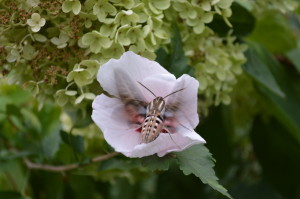
A whitelined sphinx hummingbird moth makes a beeline for a Rose of Sharon on Saturday, Sept. 14, 2013, in Cedar Rapids, Iowa. (photo/Cindy Hadish)
If you’re being buzzed in the garden by something much larger than a bee, take a closer look.
Hummingbird moths, the common name for hawk or sphinx moths, appear to be abundant this year. Perhaps Iowa’s drought is offering prime weather conditions for these fascinating insects.
Often mistaken for a hummingbird, the rapid pulse of the moth’s wings resembles that of its namesake.
Whitelined sphinx is one of the many varieties of hummingbird moths commonly seen in the state.
Gardeners who notice a large green hornworm defoliating their tomatoes may be tempted to do away with the caterpillar, but the moths are important pollinators, so consider it worth the sacrifice of a plant or two.
Iowa State University’s Department of Entomology offers more information about hummingbird moths.
Colorado State offers a comprehensive look at hummingbird moths, with a few more photos.
About.com also provides an overview of hummingbird moths and describes the difference between these moths and hummingbirds.


I have seen a few: http://crgardenjoe.wordpress.com/2013/09/12/an-odd-day-when-rain-makes-bugs-like-birds/
They seem ubiquitous this year!